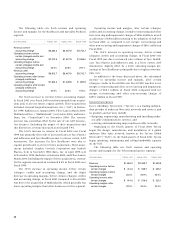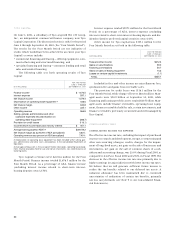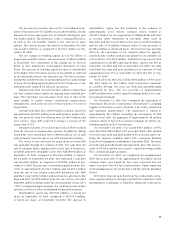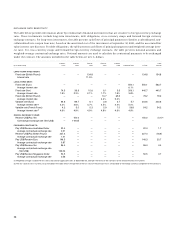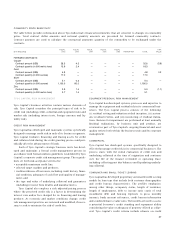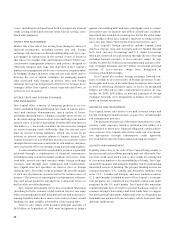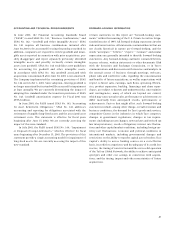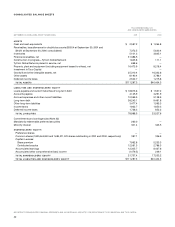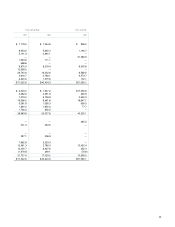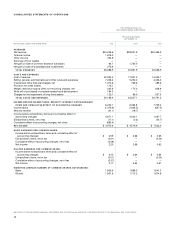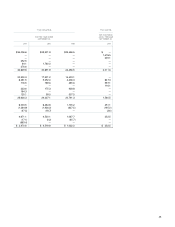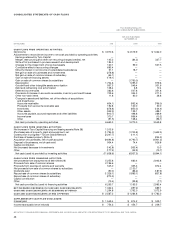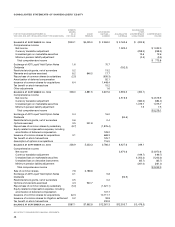ADT 2001 Annual Report Download - page 40
Download and view the complete annual report
Please find page 40 of the 2001 ADT annual report below. You can navigate through the pages in the report by either clicking on the pages listed below, or by using the keyword search tool below to find specific information within the annual report.
38
scores, including those based upon both its proprietary internal
credit scoring model and external credit bureau scoring, com-
bined with judgment.
MARKET RISK MANAGEMENT
Market risk is the risk of loss arising from changes in values of
financial instruments, including interest rate risk, foreign
exchange risk, derivative credit risk and liquidity risk. Tyco Cap-
ital engages in transactions in the normal course of business
that expose it to market risks, and maintains what it believes are
conservative management practices and policies designed to
effectively mitigate such risks. The objectives of Tyco Capital’s
market risk management efforts are to preserve company value
by hedging changes in future expected net cash flows and to
decrease the cost of capital. Strategies for managing market
risks associated with changes in interest rates and foreign
exchange rates are an integral part of the process, because those
strategies affect Tyco Capital’s future expected cash flows, as
well as its cost of capital.
INTEREST RATE AND FOREIGN EXCHANGE
RISK MANAGEMENT
Tyco Capital offers a variety of financing products to its cus-
tomers including fixed and floating-rate loans of various matu-
rities and currency denominations, and a variety of leases,
including operating leases. Changes in market interest rates, or
in the relationships between short-term and long-term market
interest rates, or in the relationships between different interest
rate indices (i.e., basis risk) can affect the interest rates charged
on interest-earning assets differently than the interest rates
paid on interest-bearing liabilities, which can result in an
increase in interest expense relative to finance income. Tyco
Capital measures its asset/liability position in economic terms
through duration measures and value at risk analysis, and mea-
sures its periodic effect on earnings using maturity gap analysis.
A substantially matched asset/liability position is generally
achieved through a combination of financial instruments,
including issuing commercial paper, medium-term notes, long-
term debt, interest rate and currency swaps, foreign exchange
contracts, and through asset syndication and securitization.
Tyco Capital does not speculate on interest rates or foreign
exchange rates, but rather seeks to mitigate the possible impact
of such rate fluctuations encountered in the normal course of
business. This process is ongoing due to prepayments, refinanc-
ings and actual payments varying from contractual terms, as
well as other portfolio dynamics.
Tyco Capital periodically enters into structured financings
(involving both the issuance of debt and an interest rate swap
with corresponding notional principal amount and maturity) to
manage liquidity and reduce interest rate risk at a lower overall
funding cost than could be achieved by solely issuing debt.
Interest rate swaps with notional principal amounts of
$6.9 billion at September 30, 2001 were designated as hedges
against outstanding debt and were principally used to convert
the interest rate on variable-rate debt to a fixed-rate, establish-
ing a fixed-rate term debt borrowing cost for the life of the swap.
These hedges reduce Tyco Capital’s exposure to rising interest
rates, but also reduce the benefits from lower interest rates.
Tyco Capital’s foreign operations include Canada, Latin
America, Europe, Asia and Australia and are funded through
both local currency borrowings and U.S. dollar borrowings
which are converted to local currency through the use of foreign
exchange forward contracts or cross-currency swaps. At Sep-
tember 30, 2001, $2.5 billion in notional principal amount of for-
eign exchange forwards and $1.7 billion in notional principal
amount of cross-currency swaps were designated as
currency-related debt hedges.
Tyco Capital also utilizes foreign exchange forward con-
tracts to hedge its net investments in foreign operations. Trans-
lation gains and losses of the underlying foreign net investment,
as well as offsetting derivative gains or losses on designated
hedges, are reflected in other comprehensive income. At Sep-
tember 30, 2001, $0.8 billion in notional principal of foreign
exchange forwards were designated as hedges of net invest-
ments in foreign operations.
DERIVATIVE RISK MANAGEMENT
Tyco Capital enters into interest rate and currency swaps and
foreign exchange forward contracts as part of its overall market
risk management practices.
The primary external risk of derivative instruments is coun-
terparty credit exposure, which is defined as the ability of a
counterparty to perform its financial obligations under a deriv-
ative contract. Tyco Capital controls the credit risk of its deriva-
tive agreements through counterparty credit approvals,
pre-established exposure limits and monitoring procedures.
LIQUIDITY RISK MANAGEMENT
Liquidity risk refers to the risk of Tyco Capital being unable to
meet potential cash outflows promptly and cost effectively. Fac-
tors that could cause such a risk to arise might be a disruption
of a securities market or the unavailability of funds. Tyco Capi-
tal actively manages and mitigates liquidity risk by maintaining
diversified sources of funding. The primary funding sources are
commercial paper (U.S., Canada and Australia), medium-term
notes (U.S., Canada and Europe) and asset-backed securities
(U.S. and Canada). Included as part of Tyco Capital’s securitiza-
tion programs are committed asset-backed commercial paper
programs in the U.S. and Canada. Tyco Capital also maintains
committed bank lines of credit to provide back-stop support of
commercial paper borrowings and local bank lines to support
our international operations. Additional sources of liquidity are
loan and lease payments from customers, whole loan asset sales
and loan syndications.


